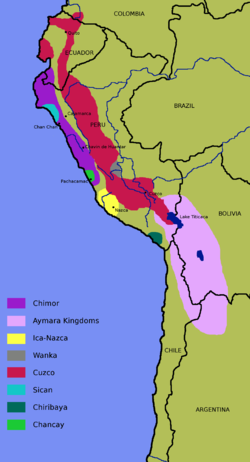Chiribaya | |||||||||
|---|---|---|---|---|---|---|---|---|---|
| c. 900–c. 1450 | |||||||||
 Extent of the Chiribaya culture in the middle of the 15th century. | |||||||||
| Location | Atacama Desert | ||||||||
| Official languages | Puquina | ||||||||
| Historical era | Late Intermediate | ||||||||
• Established | c. 900 | ||||||||
• Disestablished | c. 1450 | ||||||||
| |||||||||
The Chiribaya culture flourished near the coast of southern Peru and adjacent Chile from 700 CE until Spanish settlement in the late 16th century. The classic phase of the Chiribaya culture was from 1000 CE until 1360 CE. The Chiribaya culture consisted of both maritime settlements along 220 kilometres (140 mi) of the Pacific Ocean coast and agricultural settlements inland in valleys of the Osmore and Tambo rivers in Peru and the Lluta river and Azapa Valley in Chile.
The lower Osmore valley, one of the centers of the Chiribaya culture, has been extensively studied by archaeologists because it appears to have been colonized by both the Wari and Tihuanco empires and the later Lupaca people and the Inca Empire. These highland empires relied on the lower-altitude valleys to supply them with agricultural products such as maize and chile peppers.
